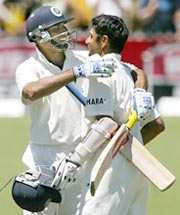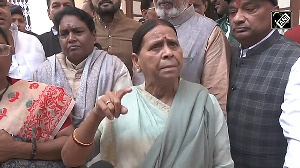Is he an artist or an artisan? The jury, out for years, has not been able to reach a verdict on Rahul Dravid.
The problem is that his batting has shades of both.
 The 32-year-old Dravid, who reclaimed his place as the world's top-ranked batsman with a century in each innings during India's 195-run victory against Pakistan in the second Test in Kolkata, is not bothered either way.
The 32-year-old Dravid, who reclaimed his place as the world's top-ranked batsman with a century in each innings during India's 195-run victory against Pakistan in the second Test in Kolkata, is not bothered either way.
He just knows he is in the zone.
Dravid has been on a superb run since taking over as India's top batsman from Sachin Tendulkar two years ago.
With an average of 58.45 -- the best for any number three batsman in history barring Don Bradman -- he is heading inexorably towards greatness.
Critics who once said he did not capture the imagination or inspire emotion like Tendulkar or West Indian Brian Lara because of his more defensive approach have started to reconsider.
Dravid's 110 and 135 in Kolkata made him only the second Indian batsman, after Sunil Gavaskar, to score two hundreds in a Test more than once. He was named man of the match in the Test, which ended on Sunday.
It is not just the volume of runs he has scored -- 2,540 in his last 25 matches at an astonishing 74.70 -- but the context in which he gets them that has made his stock rise suddenly.
Dravid is at his best when the chips are down, his most memorable knocks coming invariably in adverse circumstances or when India are pushing for victory.
TECHNICAL PERFECTION
The only overseas win in recent times to which he did not contribute with the bat was against Pakistan at Multan last year, when he was leading the side in Sourav Ganguly's absence.
Not long ago, however, there was a danger that Dravid would be consumed by a quest for technical perfection.
| |||||||||||
Former Australia captain Ian Chappell said Dravid needed to be told that matches were won not by hours but by runs or wickets. He was nicknamed "The Wall" for his stonewalling ability, though fans also gave him the more taunting sobriquet of Rahul "Well Left" Dravid.
When he did manage to get a big score, he was somehow always overshadowed by a colleague.
Right from his debut 95 at Lord's in 1996, when Ganguly cracked 131, Dravid was upstaged by a teammate whenever he did well.
He was involved in a world record one-day international stand of 318 with Ganguly against Sri Lanka in the 1999 World Cup. Dravid made a masterly 145 but Ganguly had a cocky 183 that included seven sixes.
 Against Australia in 2001, Dravid scored 180 in India's greatest Test partnership of 376 but it was Vangipurappu Laxman who grabbed all the plaudits with his 281.
Against Australia in 2001, Dravid scored 180 in India's greatest Test partnership of 376 but it was Vangipurappu Laxman who grabbed all the plaudits with his 281.
Even when Dravid scored 148 at Headingley in 2002, Tendulkar trumped him with a 193 that took him past Bradman's 29 centuries.
JINX BROKEN
Dravid changed the script at The Oval in the following Test, hitting a flawless 217. When he walked back to the pavilion, India had amassed 508 and the next highest score was Tendulkar's 54. He had finally broken the jinx.
Since then, there has been no looking back.
His centuries have moved from nine to 20 and his average from the late 40s to nearly 60.
When he struck a century against West Indies in Mumbai in 2002 he became only the fourth player in Test history, after West Indian Everton Weekes, Australian Jack Fingleton and South African Alan Melville, to score hundreds in four consecutive innings.
Dravid has grown in stature in India, where cricketers are worshipped. He is seen as a role model because of his pleasant looks, grit, determination, reliability and good manners.
He was picked as the 2004 Youth Icon, ahead of Bollywood actor Amitabh Bachchan, in a nationwide poll conducted by music channel MTV.
Predictably, Dravid described the award as "humbling".
With a keen sense of history, Dravid is well aware of all that he has achieved.
"Cricket is a learning process, I'm learning all the time," he said. "I'm still trying to improve, I'll keep doing that."
SMS: CRIC to 7333 for Cricket news/scores; SPRT for latest Sports news








 © 2025
© 2025